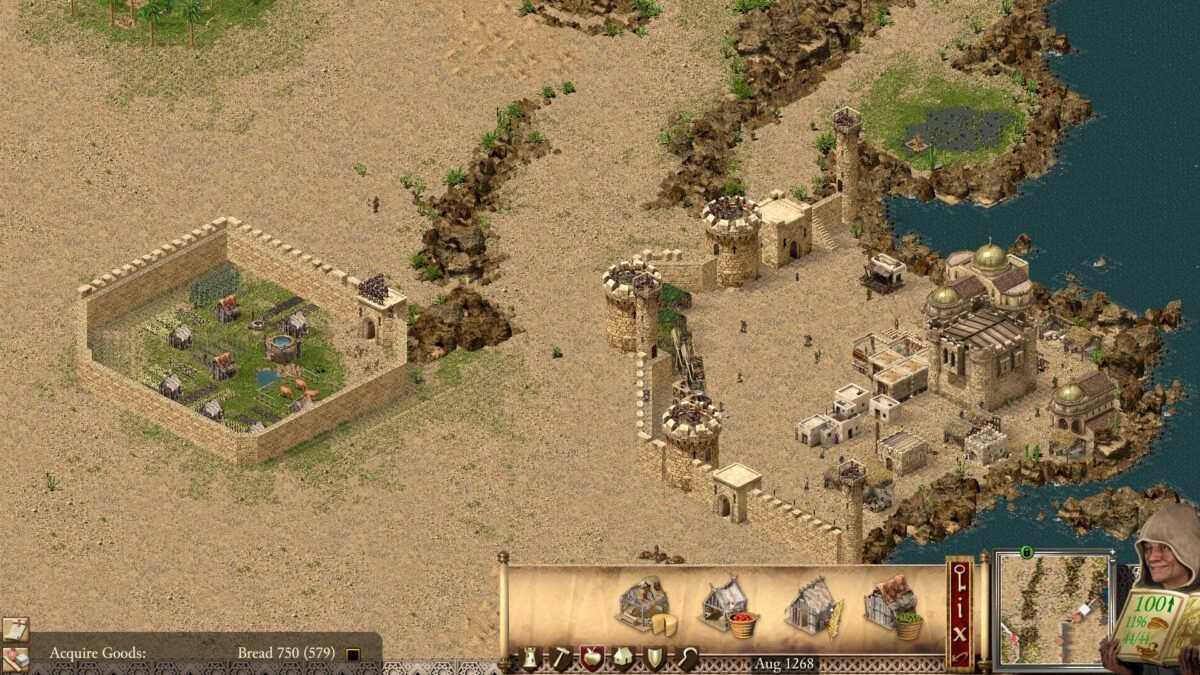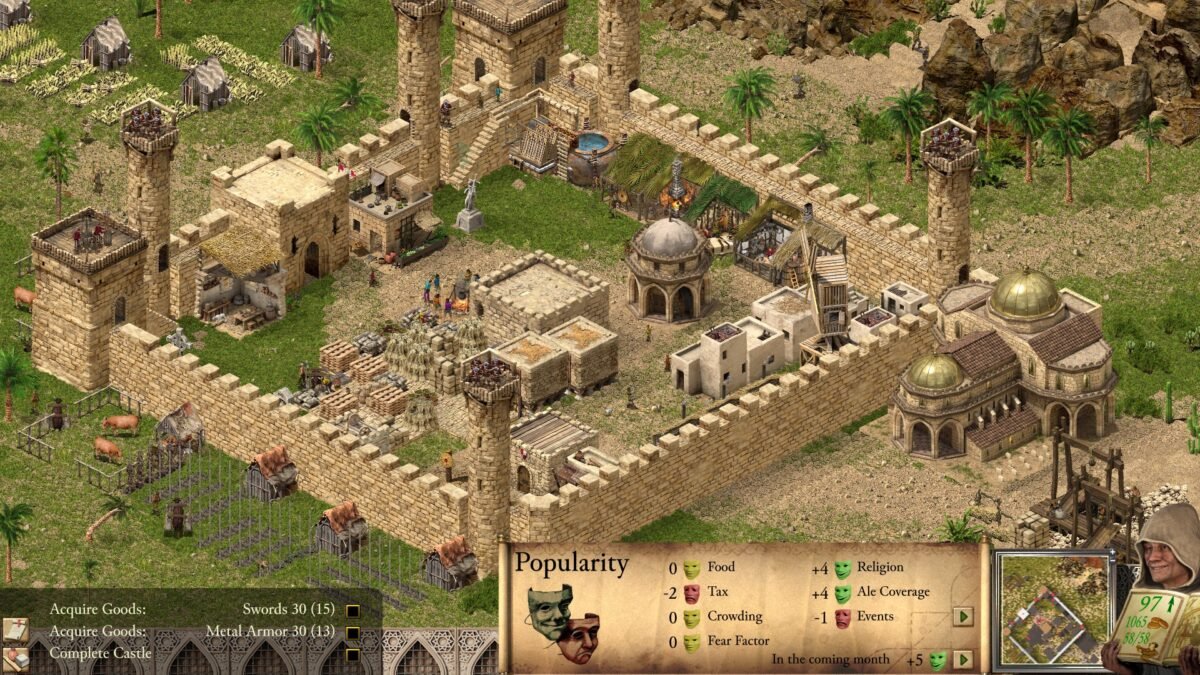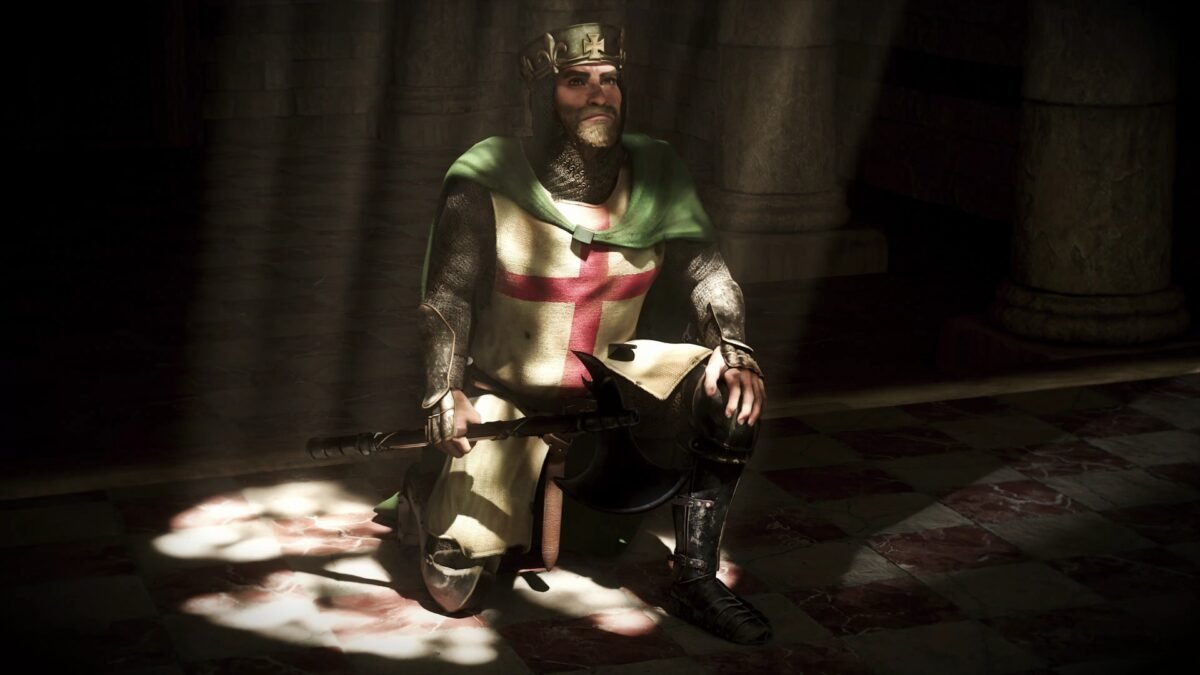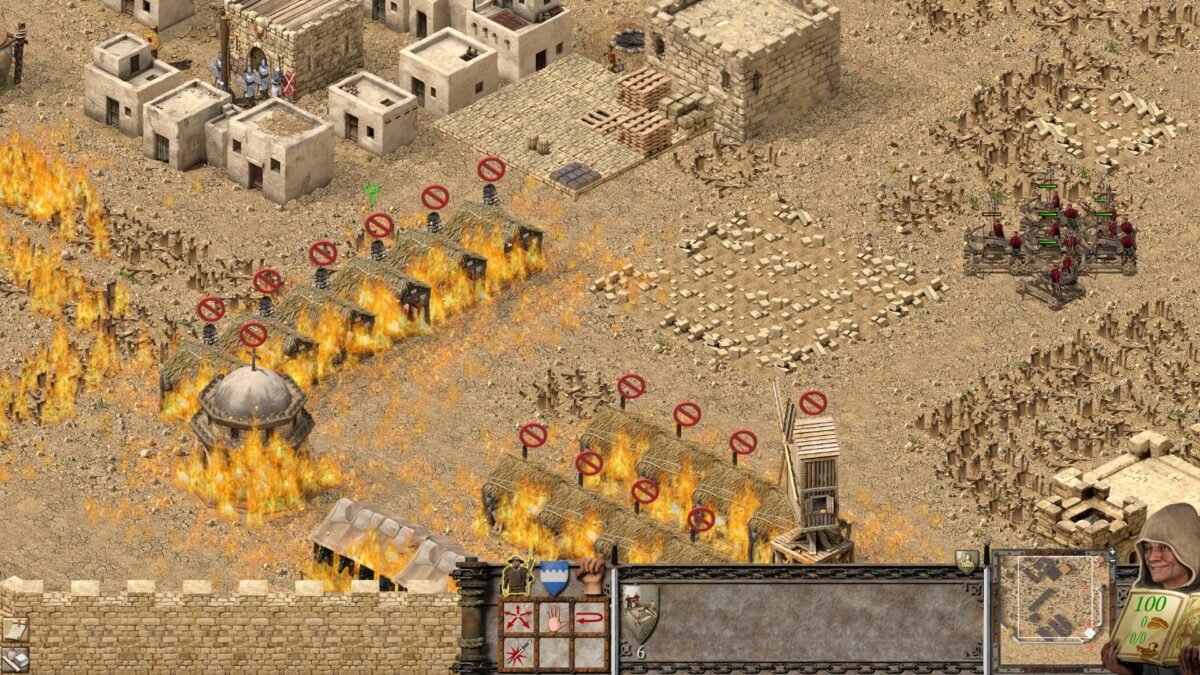Stronghold Crusader puts you in the blazing desert with countless enemies at your disposal, and it gives you nothing but a castle, wood, and a dozen people to start your journey. And it was an adventure of a lifetime, as I witnessed my citizens dying from starvation to getting scorched in the flames inside their own homes by raiding flamers. Having never played a single Stronghold Crusader game, I was afraid of getting overwhelmed by its system. Stronghold Crusader managed to slowly introduce me as a newcomer to all of its mechanics without creating any frustration. The game is difficult but at the same time forgiving; it wants you to understand its mechanics and play by its set of rules to master the challenges. Here is our review of Stronghold Crusader Definitive Edition.
Getting Lost in the Desert

You can make a mirage in the desert, or a gravestone; the options to create both are handed to you the second you boot the game. The feeling of setting up a castle in the barren land with nothing but tumbleweed rolling from one corner to another, with the desert music blaring at my face, is a feeling only a few games can deliver.
The Arabian setting does play incredibly well with the narration and the breathtaking desert music that creates a magical atmosphere. In contrast, the visual graphics might not match the 2025 standard, but the music of the game and the artistic direction bond well with each other. The original game came out in 2002, and this edition has done a commendable job of lifting up the art style. People who have played the original are in for a treat as the paint brush of remastering has hit every square pixel on the screen.
Stress, Dread, A Sense of Overcoming Gameplay

Like any RTS game, overcoming the challenge requires dealing with the stress of starvation from dwindling ration stocks, lack of the leader’s popularity, constant attacks from enemies & wildlife, decisions, and more decisions, each creating their own domino effect, the very second it gets made. The game has an overwhelming number of gameplay mechanics, but it redeems itself by setting up the campaign that acts as a tutorial of the game. Each campaign mission introduces new mechanics to the game, basically preparing you for the full game against online.
The major highlight of the game is its way of introduction to its sheer gameplay mechanics. Each campaign mission tells a story at the beginning, but they serve as a tutorial for the game. And the game did balance the introduction and limited hand-holding pretty well. By setting the tutorial as part of the Campaign mission, learning the gameplay mechanics becomes the best way to get familiar with the game. Making decisions in the Missions (Tutorial) had thousands of consequences, which led me to witness loads of different endings, all bad.
It’s all about learning from mistakes, from running out of rations to seeing a raging fire scorching all the buildings. Each failure did push me to deal a bit better the next time, where I learned putting a well next to the building could help douse out the fire quickly, or creating more wheat farms and bakeries can lead to more food production. These are some of the lessons that come in the form of failure, and the game does an excellent job of limiting the scale rather than opening up every mechanic.
Bloody Battle of the Crusades

Most of the time, you will be looking at the same building block in every new mission, but reading the few lines before starting the mission gives out all the details for the mission scene. In one mission, I was in charge of the production of bread to keep the people happy, and in a different mission, I found myself controlling an army fleet to take out a castle. Two different mechanics of the same game, but implemented in two missions.
The first mission teaches you the basics of the game, but again with consequences. At the end of the first chapter, I learned to seize Jerusalem with an army. The game does go from 0 to 100 quickly, and mistakes are woven throughout the gameplay. Once I got myself used to the game, it’s all about finding neat tricks to survive.
The game offers an incredible variety in its base-building mechanics and combat. I created buildings to store food, a variety of farming, churches, wells, stonewalls, a brewery, an inn, barracks, an armory, siege weapons, stone walls, hidden spikes on the ground, dog cages, and many, many more buildings. Each serves a purpose, and some of them do carry a lot of weight; not placing them results in immediate or slow demise of the game.
The game is very welcoming to the new player, as it also offers Cheats in the main menu, but activating them disables the achievements. When I was starting the game, I stumbled upon one mission that became an irritating venture, as I was slowly getting used to the familiarity of the game. I did finish the mission using cheats, but as I progressed through the game, learned new mechanics, I returned to the previous chapter to beat it without cheats. It can be very daunting to understand every aspect of the game all at once.
Minor Gameplay Inconveniences

I did stumble upon some irritating problems that did manage to cause a lot of annoyance. Once, I placed a mill next to another, close to the edge of the map. This made one of the mills non-functional. Unfortunately, I found the problem in the middle of the campaign mission, where the objective was to get over 700 breads. The placement of buildings has to be perfect with enough breathing room to let people pass, blocking out the building can cause problems, which sadly lead to many of my people dying of starvation because the wheat farmers couldn’t get access to the storage.
One of the major gripes I had with the game is the camera rotation; pressing Q and E allows for the rotation, but the smoothness of the camera rotation is missing. Q and E felt as if I was staring at four different screenshots of the gameplay. But it wasn’t a deal breaker, just leaned on the more annoying aspect of the game. It happened to me in one mission, where the enemy’s siege machinery was hiding behind a stone tower. But these are rare occurrences that can be overlooked as the main game earns your time.
Conclusion
What Works
- The Ambience and the Sound
- Intense gameplay, every choice matters
- Tutorialized missions with a bit of story and difficulty option (impact objectives)
- Sheer options for base and army building
- Sandbox mode for castle crafting
- Skirmish Modes for newer and veteran players
What Didn’t
- Camera control and some minor game issues
9/10
Stronghold Crusader Definitive Edition carries content that will keep you busy for a long time. The missions are just to prepare you for the online or the Skirmish mode, where your experience will be put against the best in the game. For people who just want to kill time, the game also offers Sandbox mode to help you build the perfect castle. Completing a few missions helped me understand the basics of the game to get started on the challenge mode. The sheer amount of content the game has to offer, mixed with the friendly newcomer introduction, is what makes Stronghold Crusader worth your time and money.


